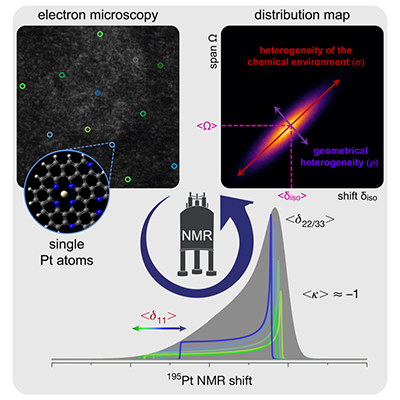CNRS press release dated August 20, 2025. Following a scientific publication to which several members of the High Field NMR Centre in Lyon contributed, namely Andrew J. Pell, lecturer-researcher (CNRS/ENS de Lyon/Claude Bernard University), Anne Lesage, engineer (CNRS/University of Lyon/ENS de Lyon), and Guido Pintacuda, researcher (CNRS/ENS de Lyon/Claude Bernard University): “Coordination environments of Pt single-atom catalysts from NMR signature”, published in Nature on June 4, 2025.
Single-atom catalysts are attracting growing interest in heterogeneous catalysis because they reduce the amount of metal used, thereby lowering the cost of the process, while also improving catalytic activity and/or selectivity. However, accurately characterising the coordination environments of each isolated metal atom, their distribution and their evolution under catalytic conditions remains a major challenge. Scientists have shown how 195Pt NMR spectroscopy can be used to accurately visualise the local environment of platinum atoms dispersed within a porous support. Better still, they have managed to track its evolution during the catalytic reaction. This is key information for improving catalytic performance.
Metals play a central role in heterogeneous catalysis by facilitating numerous reactions. Their dispersion in the form of isolated atoms on a support not only allows for optimal use of these elements but also significantly improves the reactivity and stability of catalysts. This approach paves the way for new catalytic strategies that could profoundly transform the field of heterogeneous catalysis.
Platinum is a prime example. It catalyzes many reactions with great efficiency, whether electro-, photo- or thermo-catalytic. However, due to its rarity and high cost, it is crucial to make the most of every atom in order to reduce the quantities required. The challenge is therefore to maximise the active surface area accessible to the reactants, in other words to expose as many platinum atoms as possible to the reactants.

More information on the CNRS website
Reference
Jonas Koppe, Alexander V. Yakimov, Domenico Gioffrè, Marc-Eduard Usteri, Thomas Vosegaard, Guido Pintacuda, Anne Lesage, Andrew J. Pell, Sharon Mitchell, Javier Pérez-Ramírez & Christophe Copéret. Coordination environments of Pt single-atom catalysts from NMR signatures. Nature 2025. DOI: https://www.nature.com/articles/s41586-025-09068-x






